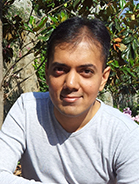|
Yoga is establishing the mind in stillness,
Then the Seer dwells in its essential nature,
Otherwise the movements of the mind are regarded as the Seer.
The Yoga Sutras
 Emotional suffering has overwhelmed humanity since time immemorial. No wonder people have been desperately on a lookout for methods to ameliorate psychological distress from way back. With rapid modernization and cultural globalization over the last few decades, the problem has intensified further. Many of us are now suffering from extreme mental distress and yearning for a powerful antidote. Some try to put their faith in contemporary psychotherapy - hoping to find a cure for psychological disorders and resurrect their life, but the outcome is mostly inconsistent and at times very discouraging.
Emotional suffering has overwhelmed humanity since time immemorial. No wonder people have been desperately on a lookout for methods to ameliorate psychological distress from way back. With rapid modernization and cultural globalization over the last few decades, the problem has intensified further. Many of us are now suffering from extreme mental distress and yearning for a powerful antidote. Some try to put their faith in contemporary psychotherapy - hoping to find a cure for psychological disorders and resurrect their life, but the outcome is mostly inconsistent and at times very discouraging.
Presently, several forms of counselling and psychotherapy are being practiced across the globe, but their underlying philosophical assumptions about human nature are quite limited. They believe that psychological problems arise when our mind acts irrationally, gets embroiled in conflicts and suffers from deficits. It is assumed that this malfunctioning happens due to an interaction of aberrant genetic, neurochemical and personality factors along with adverse and traumatic life experiences.
Counselling and psychotherapy encourage and train distressed persons to think rationally, sort their intrapsychic conflicts and either fix or accept their deficits so that their pain becomes manageable, and they can plod through life with some relief. As Sigmund Freud put it, the goal of a contemporary psychotherapist is quite modest - to offer the possibility of transforming neurotic misery into ordinary human unhappiness.
There should be no problem with psychotherapy keeping a modest goal - only if it achieves the goal and if the achievement is commensurate with the effort that goes in. Sadly, this isn't true - there are many people who continue to be overwhelmed by psychological problems despite taking years of expensive treatment. It is time that we rely upon a perfect method to bring healing and happiness to those suffering from mental distress. One such method is yoga, which aspires for a unification of the individual soul with the Divine.
Yoga was developed in ancient India by different seers and sages helping individuals unite with the Divine and experiencing perfection at all levels. Although historically yoga developed amidst the three great Indian religions - Hinduism, Buddhism and Jainism, but yoga is not a religion. It is an experiential study of consciousness and can be practiced by everyone within the context of their own religious traditions. Individuals from different religious and philosophical backgrounds practicing yoga develop self-awareness, deepen their faith and become spiritually evolved.
There are different systems of yoga: ashtanga yoga, bhakti yoga, hatha yoga, integral yoga, jnana yoga, karma yoga, kriya yoga, kundalini yoga, raja yoga and surat-shabad yoga. These systems represent diverse creative pathways to approach and have a union with the Divine. Some people experience the heights of consciousness through one method while others benefit from a different path and there are others for whom a combination works out to be the best.
Fixing psychological disorders has never been the end goal of yoga, but only a stepping stone in the evolution of consciousness. According to the yogic thought, we suffer because of our flawed psychological make-up that keeps us away from realizing who we really are. When all the fluctuations and illusions of the mind are removed through practice, detachment and surrender, our individual consciousness gets united with the supreme consciousness. Then there is freedom all kinds of suffering and we experience bliss, harmony and perfection.
A method based on the yogic thought combining the best of ancient wisdom and contemporary psychology works wonders. It sees contemporary psychotherapy and yoga on a continuum. When someone has a fragile self, contemporary psychotherapy is of great help initially in strengthening it, but once reasonable strength has been achieved, the person is introduced to yoga. Through yogic work the false self is dissolved, and the person finally awakens to the higher Self within.
|